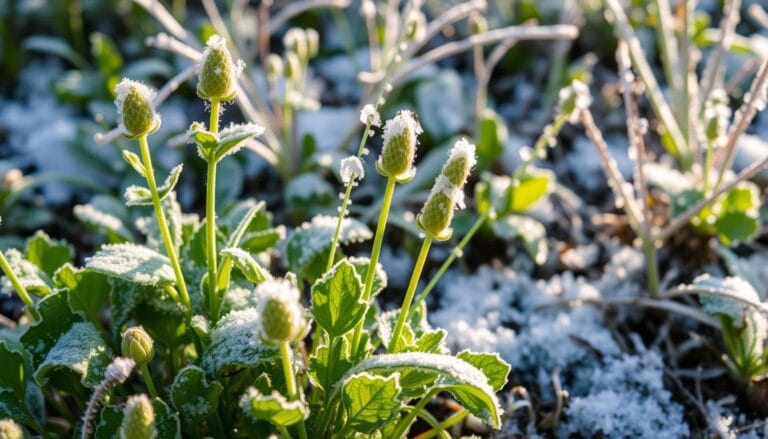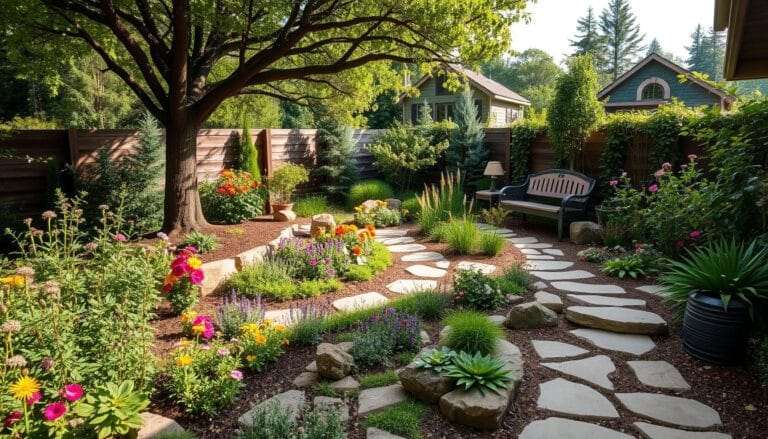Johnathan Green Grass Seed: Tips for a Healthy and Lush Lawn
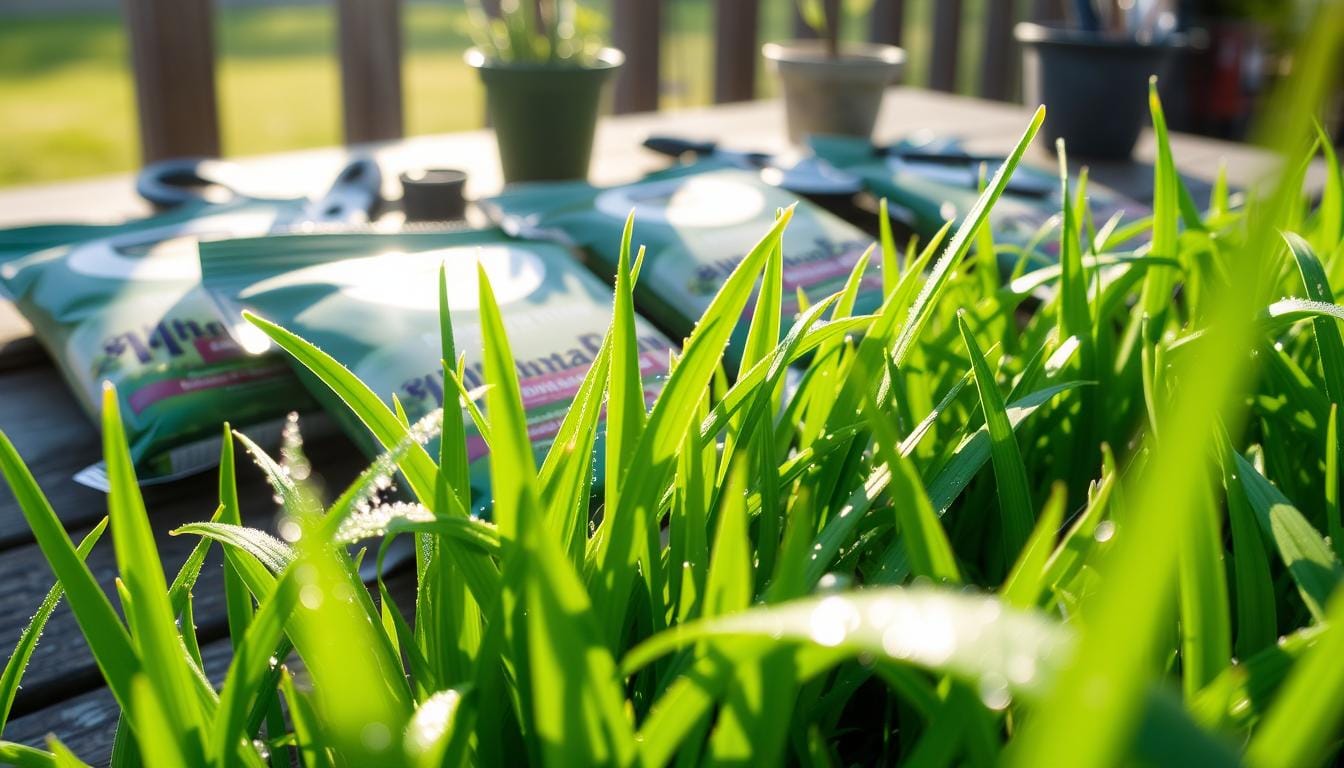
As the sun shines on your yard, you might dream of a lush, green carpet. This carpet would make your outdoor space stand out. The secret to this dream is the quality of your grass seed.
Johnathan Green offers top-notch seed blends for your lawn. These blends are perfect whether you’re starting fresh or updating your yard.
Choosing the right grass seed can change your lawn’s look, strength, and health. With Johnathan Green, you get a wide range of seed types. Each is made for different soils, weather, and how much foot traffic it gets.
Knowing how quality grass seed works with your local environment is key. This knowledge will help you grow a lawn that everyone will admire.
Table of Contents
Understanding Grass Seed Basics
Choosing the right grass seed is key to a healthy lawn. Different types of grass seed are designed for specific needs, like shade tolerance or quick growth. Knowing the difference between warm-season and cool-season grasses helps you pick the best for your area and soil.
Benefits of Quality Grass Seed
Quality grass seed offers great benefits. For example, Jonathan Green Black Beauty Original Grass Seed Mix keeps your lawn healthy all year. It also has deep roots for drought resistance and fights off pests and diseases.
The Crown Jewel Elite Tall Fescue Grass Seed is another top choice. It’s tough, can handle drought, and does well in both sun and shade.
Warm Season vs Cool Season Grasses
- Warm-season grasses, like Bermuda and Zoysia, love the heat and can handle drought. They’re perfect for southern U.S. lawns.
- Zoysia grass grows slowly but needs less mowing because it’s dense. It’s great for many soil types and some shade.
- Cool-season grasses, such as Kentucky bluegrass and fescue, do well in cold weather. They have underground stems for quick recovery. But, they need regular watering and fertilizing.
- Perennial ryegrass germinates and grows fast. However, it needs more water than other cool-season grasses to stay healthy.
Impact on Lawn Health
Choosing the right grass seed is crucial for your lawn’s health. Warm-season grasses, like Bermuda and Zoysia, do well in the sun and need less care. Cool-season grasses, such as Kentucky bluegrass and fescue, are better in cold weather but need more water and food.
“Selecting the appropriate grass seed for your lawn is the first step towards a lush, healthy, and low-maintenance outdoor space.”
Selecting the Right Johnathan Green Grass Seed
Choosing the right grass seed is key to a lush lawn. Johnathan Green offers many high-quality seed mixes. Their 25# Black Beauty Original Grass Seed Mix is perfect for full sun to partial shade.
The Black Beauty mix is enhanced with endophytes. This makes the grass resistant to pests and diseases. It also has a deep root system, making it drought-tolerant.
When picking the best Johnathan Green grass seed, think about your climate, seed mix, and lawn use. Consider how much traffic it will get and your budget. This way, you can pick the perfect seed for a beautiful lawn.
Warm-season grasses like Bermuda and Zoysia do well in the south. Cool-season grasses like Kentucky Bluegrass and Fescue are better in the north. Centipede Grass is easy to care for in warm areas, while St. Augustine Grass loves shade.
Choosing the right seed for your lawn is crucial. It sets the stage for a healthy, vibrant lawn that will impress your neighbors.
| Grass Variety | Climate Preference | Key Features |
|---|---|---|
| Bermuda Grass | Warm-season | Quick growth, dense turf |
| Zoysia Grass | Warm-season | Adaptable to various soil types |
| Kentucky Bluegrass | Cool-season | Lush, vibrant appearance |
| Fescue | Cool-season | Retains color in fall and spring |
| Centipede Grass | Warm-season | Low maintenance, tolerates shade |
| St. Augustine Grass | Warm-season | Thrives in shaded areas |
Essential Soil Preparation Techniques
Getting your soil ready is key to a great lawn. Testing, amending, and conditioning your soil helps your grass seed grow well. Here are the main steps to prepare your soil for a successful lawn.
Testing Soil pH
First, test your soil’s pH level. This tells you if your soil is too acidic or alkaline. Grass grows best in a pH between 6.0 and 7.0.
Soil Amendment Methods
If your soil test shows you need amendments, there are choices. Adding compost or peat moss can help your soil. You might also need lime or sulfur to adjust the pH. Use your test results to choose the right amendments for a healthy lawn.
Ground Preparation Steps
- Clear the area of debris like leaves, twigs, or rocks.
- Use a rototiller or cultivator to loosen the top 2-4 inches of soil.
- Make sure the surface is even to avoid puddles or poor drainage.
- Add any needed soil amendments, like fertilizers or organic matter, to the top layer.
By following these steps, you’ll get your lawn off to a great start. Good soil preparation is crucial for your grass seed to grow and for long-term lawn care.
Best Time to Plant Your Grass Seed
Planting your grass seeding tips at the right time is key to a lush lawn. The best time varies based on your local climate and the grass type.
Cool season grasses do best in early fall or early spring. They grow well in cooler weather and need moist soil to grow strong roots.
- In early fall, the soil is warm, and the weather is mild. This is perfect for grass seeds to sprout and grow before winter.
- Early spring planting takes advantage of plenty of rain and mild temperatures. It gives the grass a good start before summer gets hot.
Warm season grasses should be planted in late spring or early summer. The soil is warm, and the days are long and sunny. This helps the grass grow well during its peak season.
It’s important to think about soil temperature, moisture, and weather when planting. Choosing the right time helps your grass grow strong and vibrant.
“The secret to a beautiful lawn is in the timing of your grass seeding.”
Professional Seeding Techniques
Getting a lush, healthy lawn starts with the right seeding techniques. Whether you’re starting fresh or adding to an existing lawn, knowing the best methods is key. Here are some top tips for successful grass seeding.
Spreader Settings and Usage
First, pick the right spreader for your lawn size and seed type. Check your Johnathan Green grass seed package for the best settings. Make sure your spreader is set up right for even seed distribution.
Coverage Patterns
For the best coverage, spread the seed in a crisscross pattern. Start by covering the edges of your lawn, then make passes across it. This pattern helps avoid missed spots and ensures even seed distribution.
Seed-to-Soil Contact
After spreading, it’s important to get the seed in contact with the soil. Use a rake to gently mix the grass seed into the soil. For overseeding, mow in a pattern to blend the new seed with the existing lawn.
By using these grass seeding tips, you’ll be on your way to a beautiful lawn. Always check your Johnathan Green seed blend package for specific advice for your grass and climate.
| Grass Seed Germination Timeline | Seeding Rate |
|---|---|
| Ryegrass: 2-3 days Kentucky Bluegrass: 5-6 days | 1-2 lbs per 1,000 sq ft |
Water Management for New Seeds
Proper watering is key for new grass seeds to grow well. Water the area well after seeding, but avoid puddles. Keep the soil moist but not too wet during germination.
Adjust how often you water based on the weather and soil. This helps your grass maintenance and lawn care efforts succeed.
Grass is mostly water, so good water management is vital. Don’t water too much in hot weather. Once or twice a week is enough to avoid too much water.
New turf needs extra care with grass seeding tips. Water lightly and often to keep the soil moist. As the grass grows, you can water less often.
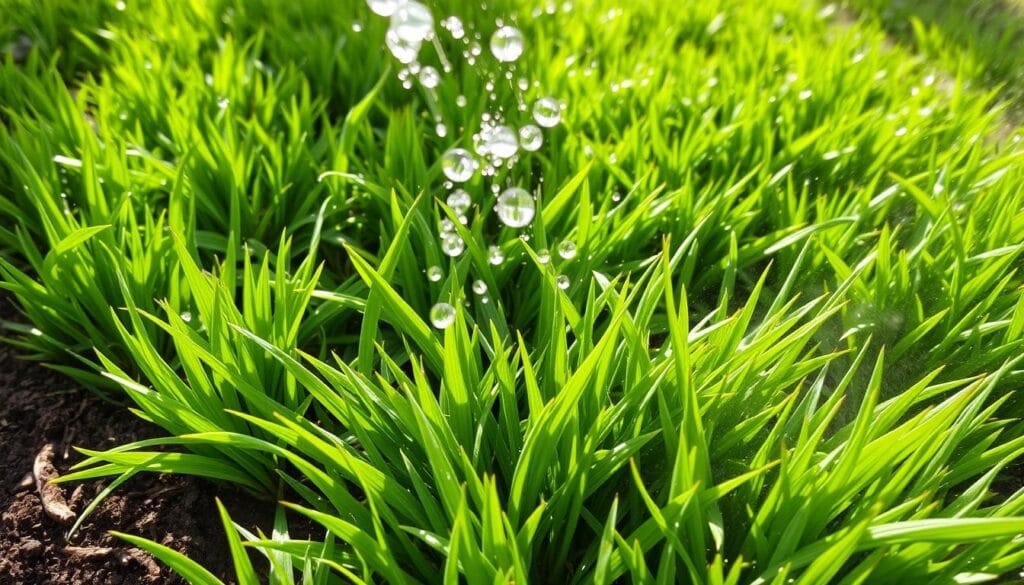
“It is advised not to water lawns too frequently during hot weather; once or twice a week is sufficient to prevent overwatering.”
By following these tips, your new grass seeds will grow into a stunning, lush lawn. Your neighbors will be green with envy.
Post-Planting Care and Maintenance
Congratulations on planting your new grass seed! Now, focus on caring for it to get a lush lawn. This section will guide you on mowing, fertilizing, and controlling weeds. It’s all about keeping your grass maintenance on track.
First Mowing Guidelines
When your grass is 3-4 inches tall, it’s time for the first cut. Be gentle and use the highest mower setting to protect the seedlings. Keep mowing at 2-3 inches to help your lawn grow thick and healthy.
Fertilization Schedule
Give your grass a boost with starter fertilizer when you seed. Then, use a balanced fertilizer every 6-8 weeks during growing season. This keeps your lawn nourished and prevents overseeding issues.
Weed Control Methods
Weeds can harm your new lawn by competing for resources. Watch your lawn closely and deal with weeds quickly. Use post-emergent herbicides for existing weeds or pre-emergent to stop new ones. Always read the product instructions to avoid harming your grass.
By following these grass maintenance tips, you’ll have a lush, healthy lawn. It will be the talk of the neighborhood.
Troubleshooting Common Seeding Issues
Starting a new lawn from seed can be rewarding but comes with challenges. If you’re dealing with issues like poor germination, uneven growth, or bare spots, there’s hope. You can take steps to fix these problems and get your lawn looking great.
First, figure out what’s causing the problem. It could be bad watering, poor soil prep, or wrong seed amounts. Knowing the cause helps you fix it and make your lawn healthy.
- If germination is weak, check your seed quality. Make sure you’re watering well and deeply to help roots grow strong.
- Uneven growth might mean uneven seed spread or hard soil. Use a spreader for even coverage and aerate to help soil breathe.
- Bare spots could need more seed or soil fixes, like pH or nutrient boosts. Test your soil and fix it before reseeding.
Remember, patience and persistence are key when it comes to establishing a new lawn. With the right tips and care, you can beat these common problems and have a beautiful outdoor space.
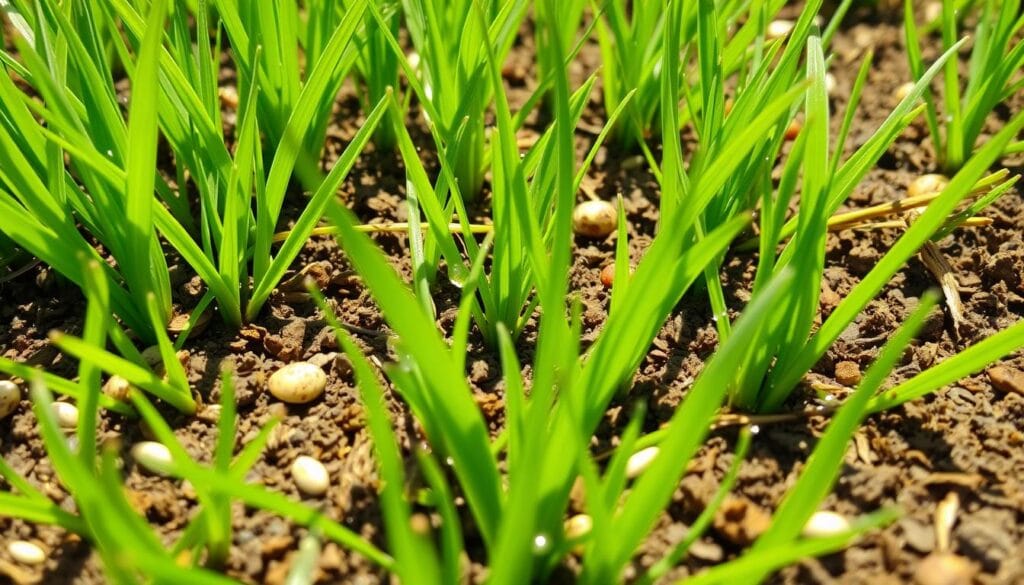
Overseeding Techniques for a Thicker Lawn
Overseeding can make your lawn thicker and cover bare spots. It’s important to time it right, based on your grass type and local weather. For cool-season grasses, fall is the best time. The cooler weather and more moisture help new seeds grow well.
Timing Your Overseeding
Warm-season grasses do better in late spring. This is when the soil is warm enough for them. Don’t overseed in summer because it’s too hot and dry for the seeds.
Application Methods
Use a spreader to spread the seed evenly. Follow your mowing pattern to cover the lawn well. Then, rake lightly to help the seeds touch the soil. This is key for them to grow strong roots.
Follow-up Care
After seeding, keep the new grass wet. Water every 2-3 days if it doesn’t rain. Also, use a balanced fertilizer to help both the new and old grass grow. With the right timing and care, your lawn will become lush and dense.
FAQ
What are the benefits of using high-quality Johnathan Green grass seed?
What are the differences between warm-season and cool-season grasses?
How does the quality of grass seed affect lawn health?
What factors should I consider when selecting the right Johnathan Green grass seed?
How do I properly prepare the soil for seeding?
When is the best time to plant Johnathan Green grass seed?
How do I properly apply Johnathan Green grass seed?
How do I properly water newly seeded grass?
What post-planting care and maintenance should I follow?
How can I address common seeding problems?
When and how should I overseed my lawn?
Source Links
- Grass Seed & Fertilizer Lawn Starter Bundle | Jonathan Green – https://www.jonathangreen.com/product/grass-seed-fertilizer-bundle/
- Full Sun | Jonathan Green – https://www.jonathangreen.com/shop/grass-seed/conditions/full-sun/
- Choosing the best grass seed for a beautiful, resilient lawn – https://growcycle.com/learn/choosing-the-best-grass-seed-for-a-beautiful-resilient-lawn?srsltid=AfmBOopBgJc5YW_y0CnhTaz0BOdxsUBfJPbQ44eGvJ8InGKVL9sMd_Em
- Show Off Your Pretty Green Lawn With the Best Grass Seed – https://www.thespruce.com/best-grass-seed-4174720
- Choosing the best grass seed for a beautiful, resilient lawn – https://growcycle.com/learn/choosing-the-best-grass-seed-for-a-beautiful-resilient-lawn?srsltid=AfmBOooVoK9bSyXUy0coRZq4fZByIVk6zZAd10s4NsiEq8bsW9hS5s01
- Lawn Starter Kit l Jonathan Green – https://www.jonathangreen.com/product/lawn-starter-kit/
- Choosing the best grass seed for a beautiful, resilient lawn – https://growcycle.com/learn/choosing-the-best-grass-seed-for-a-beautiful-resilient-lawn?srsltid=AfmBOop3NB-w9LaN9jbY6wce-0FGkFbUnTkB6_GLenJ7I-GwtjbOhNfC
- Grass seed methods, timing, etc. – https://www.bogleheads.org/forum/viewtopic.php?t=423028
- How to Pre-Germinate Grass Seed – https://lawnlove.com/blog/how-to-pre-germinate-grass-seed/
- Seeding the Lawn | Petitti Garden Centers – https://www.petittigardencenter.com/seeding-the-lawn-2/
- Fall Lawn Care Tips for a Healthy Spring – 16 Acres Garden Center – https://16acresgardencenter.com/2024/09/04/fall-lawn-care-tips-for-a-healthy-spring/
- Can you water grass in the sun? Yes, but it’s better to pick the right time of day, say lawn experts – https://www.idealhome.co.uk/garden/garden-advice/can-you-water-grass-in-the-sun
- How Long After Weed and Feed to Plant Seed? – https://www.lawnstarter.com/blog/lawn-care-2/how-long-after-weed-and-feed-can-you-plant-seed/
- Choosing the best grass seed for a beautiful, resilient lawn – https://growcycle.com/learn/choosing-the-best-grass-seed-for-a-beautiful-resilient-lawn?srsltid=AfmBOoohXlnzIdltUS-6l2wYLiX2aLvz44QWi2auOhCAe7zvFKTa1vRf
- 9 FAQs About Applying Starter Fertilizer to Your Lawn – https://www.lawnstarter.com/blog/lawn-care-2/9-faqs-about-applying-starter-fertilizer-to-your-lawn/
- Best Grass Seed for the Midwest – https://www.lawnstarter.com/blog/lawn-care-2/best-grass-seed-midwest/
- Best Grass for Northern Nevada – https://lawnlove.com/blog/best-grass-northern-nevada/
- How to overseed a lawn – a step-by-step guide to repairing damaged grass – https://www.homesandgardens.com/gardens/how-to-overseed-a-lawn
- Fall Lawn Care Tips for a Healthy Spring – Town & Country Nurseries – https://townandcountryhaddam.com/2024/09/09/fall-lawn-care-tips-for-a-healthy-spring/
There are no reviews yet. Be the first one to write one.

